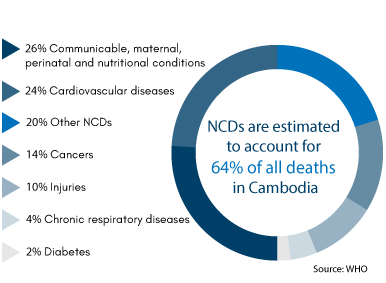

WHY NCDS
WHAT ARE NCDS?
The modern world has given rise to a particular group of diseases, known collectively as noncommunicable diseases (NCDs).
Socio-economic, environmental and behavioral and biological factors can all increase our risk of contracting these diseases. In the past NCDs were strongly associated with wealth and ageing.
Today four out of five people with an NCD live in a low- or middle-income country, and many more are increasingly at risk.
NCDS IN CAMBODIA
Impressive economic growth accompanied by urbanisation, air pollution, dietary change, an ageing population, and a reduction in physical activity, is resulting in a sharp and dangerous increase in NCDs.
Tackling the epidemic requires collaboration beyond the health sector with policy interventions addressing key risk factors, in addition to significant investment in clinical interventions to treat and manage NCDs.
Failure to address NCDs will threaten the achievement of national health and development goals.
PROPORTIONAL MORTALITY
IN CAMBODIA

RISK FACTORS IN CAMBODIA

-
32.9% of all men smoke compared to 2.4% of women
-
The equivalent of 3% of GDP is lost annually due to tobacco-related illness
-
Latest data shows only 8% of adults aged 18-69 are sufficiently physically active
-
19.2% of adults are overweight, and 3% are obese with rates higher among women
-
9.6% of adults over 18 have raised blood glucose
-
45% of adults had raised total cholesterol
-
14.2% of adults over 18 had raised blood pressure

-
NCDs cause 64% of all deaths in Cambodia
-
One in four Cambodians dies prematurely, before the age of 70 from one of the four main NCDs
-
Deaths from NCDs have increased from 46% of all deaths in 2011, to 64% in 2018
-
Cardiovascular diseases are the leading cause of NCD deaths (24%) followed by cancers (14%)
-
Between 2010 and 2016 pre-diabetes (impaired fasting glycemia) rates saw a sharp rise for both men and women from 1.4% to 9.6%
NCD DISEASE BURDEN
SOCIO-ECONOMIC
IMPACTS OF NCDs

-
The total economic burden of NCDs to the Cambodian economy is US$ 1.5 billion per year, equivalent to 6.6% of the annual gross domestic product (GDP)
-
Total government expenditure on health was US$ 281 million; almost 30 percent on the four main NCDs
-
CVDs account for the major share of government health spending at 13.4 percent followed by cancers (6.7%), respiratory diseases (5.8%) and diabetes (4%)
-
Increasingly the Loss of employment and income are driving vulnerable people into poverty due to NCD-related disabilities and treatment costs
-
For people with an NCD, out-of-pocket expenditure on health accounts for a third of their monthly income, compared to only 3% for those without an NCD
